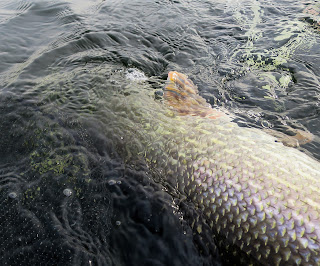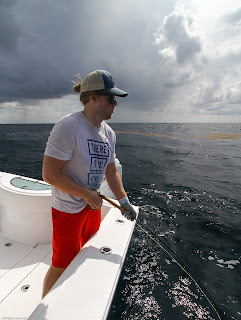Fishing the dreaded sinking line in saltwater/stillwater
 |
| Sturdy and stiff tipped 12wt rod rigged with a 500grain sinking line and a heavy fly. Ready to do some damage on big Coalfish. |
When we fly fishermen talk about saltwater fly fishing, we tend to think about crystal clear flats, small flies and sight casting at fish. And why not? Who doesn't enjoy casting small flies at cruising fish in shallow water? There is however so much more to experience in the deep blue waters of the oceans (and freshwater too!) with a fly rod in hand and fishing a sinking line makes many of those things possible.
 |
| My good good friend Pasi with a Cape Lookout ocean dwelling Red Drum caught on a sinking line. |
 |
| Early days of my sinking line career with Capt. Gil Berke and a big Striped bass |
There are many many different ways to fish the sinking line and I'm only going to scratch the surface with this little article. I'm going to go through a few basic things about the way I do my sinking line fishing most of the time.
The set up
Rods
If you want to make things as comfy as possible you should pick the fly rod that you are going to use with the sinking line accordingly. Rods with a stiff (or should I say stiff enough) tip and plenty of juice in the mid to upper low part work best for me. I actually have a few rods that have a spare tip that is cut down a inch or two to make it stiffer for the sinkers. Even though I'm usually a 9 footer man, I do enjoy using a shorter rod with the sinking line. Many times short rods naturally have a better taper to handle sinking lines and heavy flies, but rod length is not super important for me as long as the taper on the rod is good.
 |
| It's good to be prepared for every kind of situation when going out. |
 |
| Ike bending out the 10wt+ glass rod to the max. That short glass rod makes one hell of a good sinking line rod. |
 |
| The red rod aka Vision Grand Daddy has proven to be an amazing sinking line rod on top of its qualities as a pike rod. |
Lines
Now that you've got a beefy fly rod in your hand we need to line it up. Most sinking lines on the market that can be used on bigger rods and bigger game are so called sink tip lines. They have 25-35feet of super fast sinking tungsten infused line at the front and the rest of the line is usually an intermediate. There are only one or two models on the market for big rods that have a sinking running line like the SA Titan 3/5/7. This is a huge flaw on the market if you ask me as there would be plenty of use for other sink tip lines with a sink 3 running line on them.
Choose your line according to your rod and fishing needs. A 350gr head is usually the best for me if I want to actually cast at fish with my 10wt rod. A 400gr or tops 450gr is good if I'm basically just dredging. On 12 wt's 450gr to 500gr is usually good if there's a need to cast at fish. 500gr to 600gr if I'm mostly just dredging. On the big big rods ( 13wt +) the line can be anywhere from 500gr to 750gr. I have been planning to make a 1000gr longer head just for dredging but haven't had the absolute need to whip one up so that plan has been postponed. For freshwater fishing there are a bit more lines to choose from and I do most of my freshwater sinking line fishing with a sink3 or sink4 line and a 9 or 10 wt rod.
 |
| Be sure to bring plenty of back up sinking lines with you when going on a trip that involves big fast fish and sinking line fishing. |
 |
| Things might get a bit wild at times as you never know what your going to hook up when going deep. You can end up loosing a lot of lines when the fishing gets real hot. |
How to fish the sinking line
The cast and strip method
There are plenty of ways to fish a sinking line as most of you probably know. The most straight forward approach is to cast your line to its intended target and then just strip the line in the same way you would do with your floating or intermediate line. The line will pull your fly a bit deeper into the water column and many times this is all you need. You can use this method with pretty much every type of fly that you can cast comfy.
The "into the wind cast and snake it out" method
When you need to reach a bit deeper and there's very little current or the drift is slow this is the right method for you. Do a short cast right into the wind/on to the opposite direction that you are drifting to. Then just "snake" out the needed amount of loose line into the water to reach your target depth and fish. The deeper you want to go the shorter your cast should be and more line you should "snake" out. The loose line will let your line and fly sink in to the "zone". Then when the line starts to come tight you start to fish your fly and strip it in. You can either strip it all the way in or just pull it half way in and then drop it again and repeat. Dropping it again gives the fly a bit more time in the zone.
 |
| Small fly and a sinking line made the deal for this big pike. Fishing deeper weed-beds with a sinking line and using smaller flies can be deadly on summer/early fall pike. |
 |
| Big Zander caught on fly is a real trophy fish. Pic by Sami Passoja. |
 |
| Un-weighted big hollow fly and a fast sinking line dropped to the right depth was the ticket for this big red drum. |
Usually this method is performed with flies that have some weight on them, but in shallower spots or with fish that are pelagic so to speak an un-weighted fly can be effective and won't get tangled up in the leader/fly line when dropping it down as you cast the fly and leader straight out before letting the line drop.
 |
| These medium sized (5-6 1/2inch) Half&Half style patterns with relatively big but light brass dumbbell eyes is probably my most used fly for the first two techniques I explained. |
 |
| Monster albies like this one are a pretty common catch offshore Florida when using a sinking line. |
Dredging
When you need to go as deep as you can or there's some serious current around the spot that you are fishing for, you need extreme measures to get your fly down.
Use a line that has the heaviest and preferably longest sinking portion you can. This also means that you will need a heavy rod. A short 13 or 14 wt is my choice most of the time. Regardless of the target species. Be sure to have plenty of running line after your sinking line as you will need it if you really want to dredge. Use a fly that sinks faster than your line. Use extra weight on your leader if you can and especially when you aren't using a super heavy fly. If the fly or leader doesn't have enough weight on it you can end up with a lot of tangles.
 |
| Heavy 6 inch or 15cm flies with heavy XXL lead eyes. Those tin plated versions weigh in at 3 grams so paired up with a heavy duty hook they end pretty darn heavy. |
 |
| Different tungsten coneheads and beads are an easy way to add some weight to your leader. |
The goal with this technique is to maximize the amount of free sinking time your line and fly can have. This means that you have to cast your line and fly as far "upstream" as you can. Then you need to "snake" out as much of free flowing running line in to the water as you can. This is especially important if there's plenty of current in the spot that you are fishing at. You will need a lot more line out than your target depth is. That's why it's important to use a set up that has plenty of extra line when going for this technique.
 |
| This is a fat albie from a nice morning of doing some hardcore dredging at Cape Lookout. Unfortunately the rod did not survive this workout:) |
 |
| Hard pulling fish in hard current is well worth all the effort. |
There you go, a few introductory words on the fascinating world of sinking line fishing. Open up your mind and expand the use of fly fishing gear and techniques in the deep blue and open freshwaters. Go out there, go to the deep end and pull as hard as you can when you get the bite.







Thanks for sharing this blog post full of information.I want to add something that everyone should use telescopic fishing rods instead of simple fishing rods because they're easy to carry and are pretty smooth to use.
ReplyDeleteNice Post Homosassa fishing trip
ReplyDeleteEnjoy a day on the water with expert guides and top-tier equipment.
ReplyDeleteCrystal River Fishing Charter provides a premium angling experience for all.